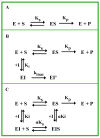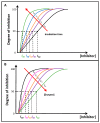Recent Advances in Electrochemical Biosensors Based on Enzyme Inhibition for Clinical and Pharmaceutical Applications
- PMID: 29315246
- PMCID: PMC5795370
- DOI: 10.3390/s18010164
Recent Advances in Electrochemical Biosensors Based on Enzyme Inhibition for Clinical and Pharmaceutical Applications
Abstract
A large number of enzyme inhibitors are used as drugs to treat several diseases such as gout, diabetes, AIDS, depression, Parkinson's and Alzheimer's diseases. Electrochemical biosensors based on enzyme inhibition are useful devices for an easy, fast and environment friendly monitoring of inhibitors like drugs. In the last decades, electrochemical biosensors have shown great potentials in the detection of different drugs like neostigmine, ketoconazole, donepezil, allopurinol and many others. They attracted increasing attention due to the advantage of being high sensitive and accurate analytical tools, able to reach low detection limits and the possibility to be performed on real samples. This review will spotlight the research conducted in the past 10 years (2007-2017) on inhibition based enzymatic electrochemical biosensors for the analysis of different drugs. New assays based on novel bio-devices will be debated. Moreover, the exploration of the recent graphical approach in diagnosis of reversible and irreversible inhibition mechanism will be discussed. The accurate and the fast diagnosis of inhibition type will help researchers in further drug design improvements and the identification of new molecules that will serve as new enzyme targets.
Keywords: diagnosis of inhibition; disease; drug; electrochemical biosensors; enzyme inhibition.
Conflict of interest statement
The authors declare no conflict of interest.
Figures







References
Publication types
MeSH terms
Substances
LinkOut - more resources
Full Text Sources
Other Literature Sources
Miscellaneous

